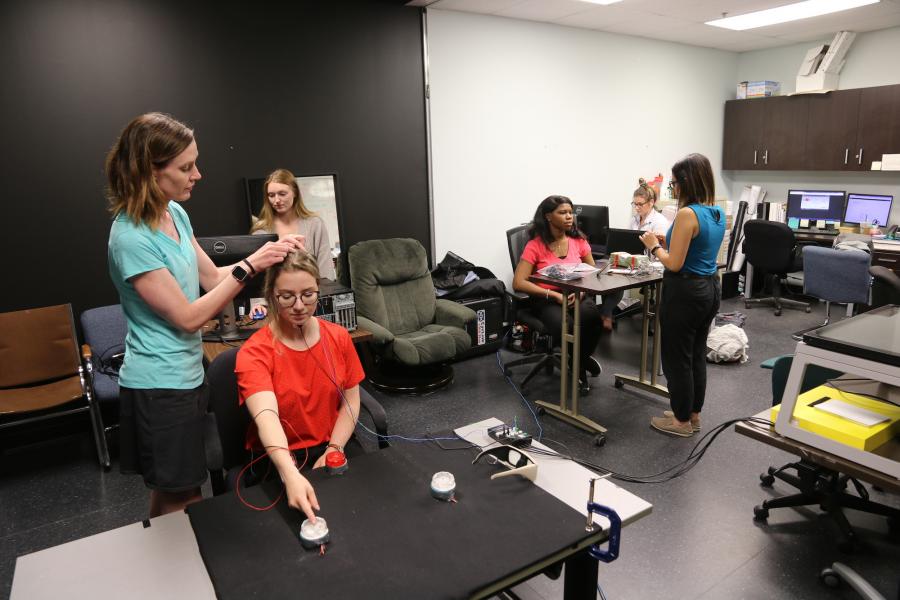Professor
118 Frank Kennedy
204-474-8773
cheryl.glazebrook@umanitoba.ca
Cheryl Glazebrook, PhD
Biography
Dr. Glazebrook’s research program seeks to understand how the nervous system integrates information from different senses (e.g., sight, sound) to perform precise movements. She manipulates the accuracy and availability of visual, auditory, and somatosensory information in order to develop principles for using multisensory information to improve motor skill learning and performance. She is particularly interested in understanding the processes of multisensory-motor integration to develop an understanding of perceptual-motor performance in individuals with developmental disorders as well as neurological disorders and injuries.
Research areas
- Motor control and learning
- Motor skill assessment and movement performance in individuals with Autism Spectrum Disorders
- Relationships between perception and action in typical and clinical populations
- Influence of multisensory stimuli on movement performance
- Eye-hand coordination
Education
- Post Doctoral Fellow, Action & Attention Lab (Dr. Timothy Welsh), Faculty of Physical Education and Health, University of Toronto (2009-2010)
- M.Sc. (Physical Therapy), Department of Physical Therapy, University of Toronto (2009)
- PhD (Kinesiology), Department of Kinesiology, McMaster University (2007)
- Hon. B.Kin., Department of Kinesiology, McMaster University (2003)
Perceptual Motor Integration Lab
-
The Perceptual Motor Integration Lab aims to establish how multisensory information can facilitate performance of skilled actions and apply these findings to the design of technology, novel rehabilitation programs, and future theoretical research. These findings lead to advancements in interventions that are cost-effective and have the ability to accurately track changes in motor performance across the lifespan.
-

Publications
Mortaza, N., Moussavi, Z., Stecina, K., Salter, J. Passmore, S.R., Gardiner, P.F., & Glazebrook, C. M. (in press). Effects of Training with a Neuro-mechano Stimulator Rehabilitation Bicycle on Functional Recovery and Paired-reflex Depression of the Soleus in Individuals with Incomplete Paralysis: A Proof-of-principle Study. The International Journal of Neuroscience.
Mortaza, N., Abou-Setta, A., Zarychanski, R., Loewen, H., Rabbani, R., & Glazebrook, C.M. (2019). Upper Limb Tendon/ Muscle Vibration in Persons with Chronic Stroke: A Systematic Review and Meta-analysis. European Journal of Physical and Rehabilitation Medicine. doi: 10.23736/S1973-9087.19.05605-3. [Epub ahead of print]
Zheng, R., Naiman, I.D., Skultety, J., Passmore, S. R., Lyons, J. & Glazebrook, C.M. (2019). The Impact of Different Movement Types on Motor Planning and Execution in Individuals with Autism Spectrum Disorder. Motor Control (00),1-20.
Passmore S.R., Johnson M.G., Aloraini S. M., Cooper, S., Aziz, M., & Glazebrook, C.M. (2019) Impact of Spinal Manipulation on Lower Extremity Motor Control in Lumbar Spinal Stenosis Patients: A Single-Blind Phase-I Randomized Clinical Trial. Journal of Manipulative and Physiological Therapeutics. 42(1), 23-33.
Glazebrook, C.M. (2018). Catching the Integration Train: A Look Into the Next Ten Years of Motor- Control and Motor-Learning Research. Kinesiology Review 7(2), 130-141.
Glazebrook, C.M., Welsh, T.N., & Tremblay, L. (2016). The processing of visual and auditory information for reaching movements. Psychological Research, 80, 757-773.
Passmore, S.R., Johnson, M., Pelleck, V., Ramos, E., Kriellars, D., & Glazebrook, C.M. (2015). Fitts’s Law using lower extremity movement: Performance driven outcomes for degenerative lumbar spinal stenosis. Human Movement Science, 44, 277-286.
Glazebrook, C.M., Kiernan, D., Welsh, T.N., & Tremblay, L. (2015). How one breaks Fitts's Law and gets away with it: Moving further and faster involves more online control. Human Movement Science, 39, 163-176.
Glazebrook, C.M., & Wright, F.V. (2014). Measuring advanced motor skills in children with cerebral palsy: Further development of the Challenge Module. Pediatric Physical Therapy 26, 201-213.
Nazarali, N., Glazebrook, C.M., & Elliott, D. (2009). The challenges of re-programming manual aiming movements for young adults with autism. Journal of Autism and Developmental Disorders, 39, 1401-1411.
Glazebrook, C.M., Gonzalez, D., Hansen, S., & Elliott, D. (2009). The role of vision for online control of manual aiming movements in persons with autism spectrum disorders. Autism: International Journal of Research and Practice, 13, 411-433.
Glazebrook, C.M., Elliott, D., & Szatmari, P. (2008). How do individuals with autism plan their movements? Journal of Autism and Developmental Disorders, 38, 114-126.
Glazebrook, C.M., Elliott, D., & Lyons, J.L. (2006). A kinematic analysis of how young adults with and without autism plan and control goal-directed movements. Motor Control, 10, 244-264.
Glazebrook, C.M., Dhillon, V.P., Keetch, K.M., Lyons, J., Amazeen, E., Weeks, D.J., Elliott, D. (2005). Perception-action and the Muller-Lyer illusion: amplitude or endpoint bias? Experimental Brain Research, 160: 71-78.

